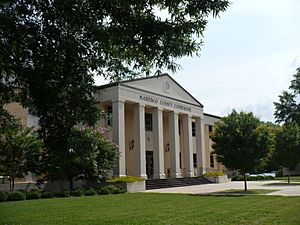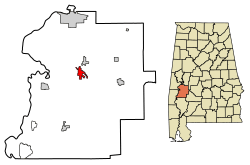Linden, Alabama facts for kids
Quick facts for kids
Linden, Alabama
|
||
|---|---|---|

Marengo County Courthouse in Linden
|
||
|
||

Location in Marengo County, Alabama
|
||
| Country | ||
| State | ||
| County | Marengo | |
| Government | ||
| • Type | Mayor/Council | |
| Area | ||
| • Total | 3.61 sq mi (9.36 km2) | |
| • Land | 3.58 sq mi (9.27 km2) | |
| • Water | 0.03 sq mi (0.09 km2) | |
| Elevation | 161 ft (49 m) | |
| Population
(2020)
|
||
| • Total | 1,930 | |
| • Density | 539.3/sq mi (208.24/km2) | |
| Time zone | UTC-6 (Central (CST)) | |
| • Summer (DST) | UTC-5 (CDT) | |
| ZIP code |
36748
|
|
| Area code(s) | 334 | |
| FIPS code | 01-43240 | |
| GNIS feature ID | 0152070 | |
Linden is a city in Alabama, United States. It is the main town, or county seat, of Marengo County. In 2020, about 1,930 people lived there. This was a bit less than the 2,123 people who lived there in 2010.
Contents
Discovering Linden's Past
Linden was settled before 1818. At first, people called the community "Screamersville." This was because they could still hear the sounds of wild animals at night.
In 1819, it became the county seat. Then, it was known as the "Town of Marengo." In 1823, the name changed again to "Hohenlinden." This new name honored the first European settlers in the county. These settlers were French refugees who had supported Napoleon Bonaparte. They came to the Vine and Olive Colony.
The name "Hohenlinden" remembered a famous battle in 1800. This battle happened in Hohenlinden, Bavaria. In that battle, the French army won against the armies of Austria and Bavaria. Later, the name was made shorter to just "Linden."
Where is Linden Located?
Linden is in the middle of Marengo County. It is about 16 miles (26 km) south of Demopolis. Demopolis is the biggest city in Marengo County. Linden is also 11 miles (18 km) west of Thomaston. It is 28 miles (45 km) north of Thomasville.
The city covers about 3.6 square miles (9.3 km2) of land. A very small part, about 0.03 square miles (0.08 km2), is water. Water from the city flows north into Chickasaw Bogue. This stream then flows west into the Tombigbee River. Water also flows south into Sycamore Creek, which is another stream that joins Chickasaw Bogue.
Understanding Linden's Population
| Historical population | |||
|---|---|---|---|
| Census | Pop. | %± | |
| 1860 | 171 | — | |
| 1870 | 300 | 75.4% | |
| 1910 | 600 | — | |
| 1920 | 700 | 16.7% | |
| 1930 | 982 | 40.3% | |
| 1940 | 1,203 | 22.5% | |
| 1950 | 1,363 | 13.3% | |
| 1960 | 2,516 | 84.6% | |
| 1970 | 2,697 | 7.2% | |
| 1980 | 2,773 | 2.8% | |
| 1990 | 2,548 | −8.1% | |
| 2000 | 2,424 | −4.9% | |
| 2010 | 2,123 | −12.4% | |
| 2020 | 1,930 | −9.1% | |
| U.S. Decennial Census 2013 Estimate |
|||
Population in 2010
In 2010, Linden had 2,123 people living in 877 households. About 23.4% of these households had children under 18. The average household had 2.25 people. The average age of people in Linden was 42.6 years.
About 51.1% of the people were White. Around 46.7% were Black or African American. A small number of people were Native American, Asian, or from two or more races. About 2.0% of the population was Hispanic or Latino.
The median household income was $20,145. This means half of the households earned more and half earned less. About 31.8% of the people lived below the poverty line. This included 41.1% of those under 18.
Population in 2020
| Race | Num. | Perc. |
|---|---|---|
| White | 833 | 43.16% |
| Black or African American | 1,034 | 53.58% |
| Asian | 1 | 0.05% |
| Other/Mixed | 45 | 2.33% |
| Hispanic or Latino | 17 | 0.88% |
As of the 2020 United States Census, 1,930 people lived in Linden. There were 672 households and 349 families.
Getting Around Linden: Transportation
Linden has a few important roads that help people travel.
US 43 runs north and south through the city. It is known as Main Street in Linden. This highway connects Linden to Demopolis in the north. It also connects to Thomasville in the south.
SR 28 goes east and west through the city. It is called Coats Avenue. This route links Linden to US 80 to the northwest. It also connects to Thomaston and Camden to the southeast.
SR 69 also runs north and south with US 43 for a while. Then, it leaves US 43 at the south end of town. It heads southwest towards Myrtlewood. From there, it connects to Butler using SR 10.
In 2021, Governor Kay Ivey announced a plan to make US 43 bigger. The plan is to expand it to four lanes from Thomasville to Tuscaloosa. When this project is finished, the expanded US 43 will likely go around Linden with a bypass.
Local News: Media in Linden
The Linden Leader is a weekly newspaper. It is based in Linden and shares local news with the community.
Learning in Linden: Education
The city of Linden has its own school system called Linden City Schools.
There was also a private school named Marengo Academy. It started in 1969. This school closed in 2019.
Famous People from Linden
Many notable people have connections to Linden:
- Ralph Abernathy – A leader in the Civil Rights Movement.
- William J. Alston – Served as a United States Representative in Congress.
- Frank Evans – A professional baseball player in the Negro leagues.
- Autherine Lucy Foster – A pioneer in the Civil Rights Movement. She was the first African-American student at the University of Alabama.
- Sean Richardson – Played as a safety for the Green Bay Packers in American football.
- Roy Rogers – A professional basketball player and coach.
See also
In Spanish: Linden (Alabama) para niños


